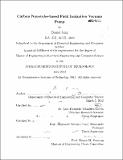Carbon nanotube-based field ionization vacuum
Author(s)
Jang, Daniel, M. Eng. Massachusetts Institute of Technology
DownloadFull printable version (13.53Mb)
Other Contributors
Massachusetts Institute of Technology. Dept. of Electrical Engineering and Computer Science.
Advisor
Luis Fernando Velásquez-García and Akintunde Ibitayo (Tayo) Akinwande.
Terms of use
Metadata
Show full item recordAbstract
We report the development of a novel micropump architecture that uses arrays of isolated vertical carbon nanotubes (CNT) to field ionize gas particles. The ionized gas molecules are accelerated to and implanted into a negatively biased getter removing the gas molecules from the volume being pumped. CNTs are ideal for field ionization because of their nano-sized diameter, high aspect ratio and of their robust chemical and mechanical structure. The ionizing CNTs are biased at a much higher electrical potential than the gate material surrounding it. Because of the high aspect ratio of CNTs, the area near the tip of the ionizing CNT exhibits very high electric field strength. Gas molecules that are in close proximity to the CNT tips are ionized when electrons tunnel from the gas molecules to the CNT tips. A negatively biased getter positioned nearby attracts the ionized gas molecules, which are implanted in the getter material. With the gas molecules removed from the enclosed space, reduction of the pressure is achieved. Key challenges in this Field Ionization Pump (FIP) project were the fabrication of high yield working pumps and a high enough ionization current at low voltages. The FIP is designed to evacuate volumes from low vacuum (30 Torr) to mid-vacuum (30 Torr). We designed the device using electrostatic simulations. Several designs for the FIP ionizers were developed, and we created a device capable of producing field ionization current of 4 nA using an array of 96 field ionizers with 700 V bias voltage at 5 - 10-⁵ Torr. We also show that ion implantation of the ionized atmospheric gas occurs in a silicon getter biased at 1000 V, which is confirmed via X-ray photoelectron spectroscopy (XPS).
Description
Thesis (M. Eng.)--Massachusetts Institute of Technology, Dept. of Electrical Engineering and Computer Science, 2012. Cataloged from PDF version of thesis. Includes bibliographical references (p. 101-105).
Date issued
2012Department
Massachusetts Institute of Technology. Department of Electrical Engineering and Computer SciencePublisher
Massachusetts Institute of Technology
Keywords
Electrical Engineering and Computer Science.